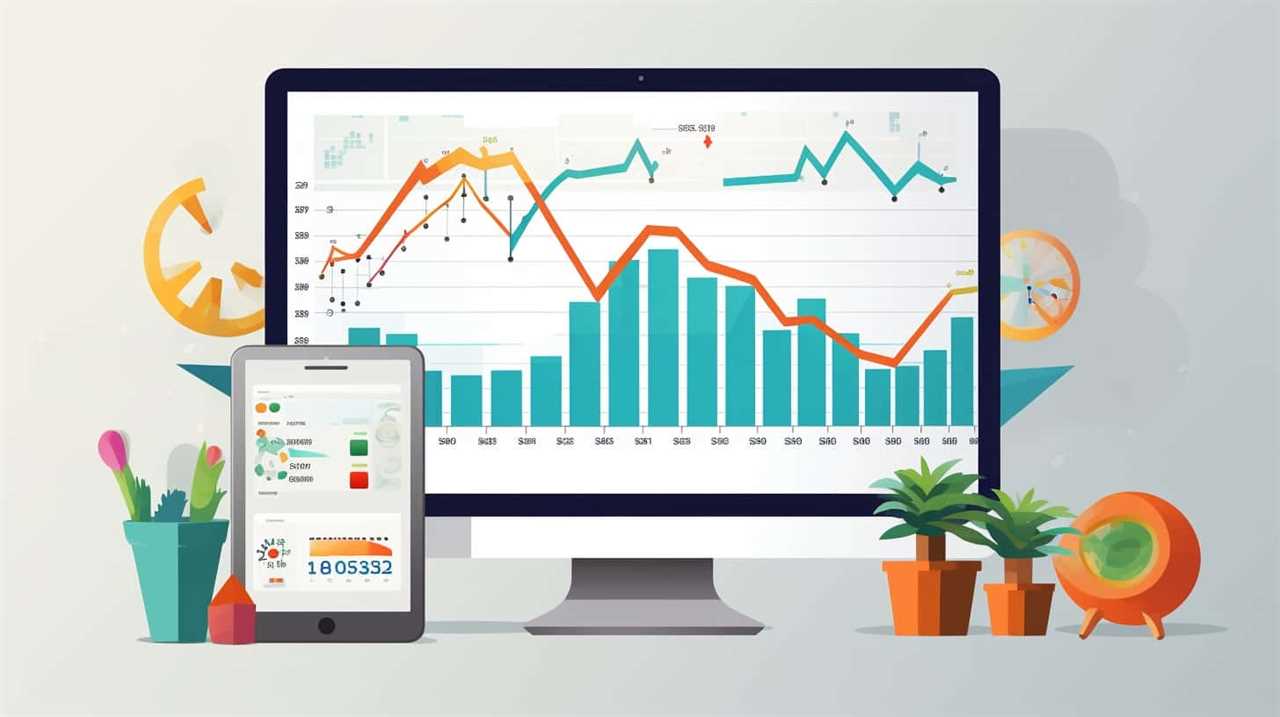Are you a farmer looking to grow your online presence? Look no further! This piece will reveal the secrets of local SEO, helping your farming business flourish on the internet.
From understanding the basics to optimizing your website and creating high-quality content, we’ve got you covered. With our tips and tricks, you’ll be sowing the seeds of online growth in no time.
So let’s dive in and watch your farm thrive!
Key Takeaways
- Conduct local market research and analyze search trends to identify target keywords.
- Optimize website and content with relevant keywords to increase visibility and attract organic traffic.
- Create location-specific landing pages with local contact information and testimonials to target customers in different areas.
- Utilize social media platforms, customer reviews, and collaborations with local influencers to increase online presence and attract customers.
Understanding the Basics of Local SEO
First, let’s dive into the fundamentals of local SEO, which we frequently employ to enhance our online presence as farmers. Understanding the basics of local SEO is crucial for farmers looking to expand their reach and attract more customers. One essential aspect of local SEO is conducting local market research. By understanding the needs and preferences of our local community, we can tailor our online presence to better meet their demands. This involves analyzing local search trends, identifying target keywords, and gaining insights into our competitors.

To implement local SEO effectively, we utilize various tools. These tools help us optimize our website and content for local searches, ensuring that we appear prominently in search engine results. For instance, we use keyword research tools to identify relevant keywords that our target audience is searching for. We then incorporate these keywords strategically in our website’s titles, meta descriptions, and content. Additionally, we leverage online directories and map services to ensure our business is accurately listed and easily found by local customers.
Conducting Keyword Research for Farm Products
To start conducting keyword research for our farm products, we begin by using a variety of tools and techniques to identify the most relevant and popular keywords in our local market. This step is crucial for effective farm product marketing and targeting local customers. By understanding the language and terms that our potential customers are using when searching for farm products, we can optimize our website and content to increase visibility and attract more organic traffic.
Here is a table showcasing some examples of keywords that farmers could consider targeting:
| Keyword | Monthly Search Volume | Competition |
|---|---|---|
| farm-fresh eggs | 1,000 | Low |
| organic vegetables | 2,500 | Medium |
| grass-fed beef | 3,000 | High |
| local honey | 1,500 | Low |
| farm-to-table | 4,500 | Medium |
By analyzing keyword search volumes and competition levels, we can prioritize our efforts and focus on targeting keywords that have a good balance of search volume and competition. This will give us the best chance of ranking well in local searches and attracting potential customers to our farm.

Now that we have identified the most relevant keywords for our farm products, the next step is to optimize our farm’s website to ensure it ranks well in local searches.
Optimizing Your Farm’s Website for Local Searches
Now, let’s focus on how we can optimize our farm’s website to improve its visibility in local searches. In order to attract more local customers and increase our online presence, we need to ensure that our website is optimized for local searches. Here are some key strategies to consider:
- Conducting market research: Before we begin optimizing our website, it’s important to understand our target audience and their search habits. By conducting market research, we can identify the keywords and phrases that our potential customers are using when searching for farm products in our local area. This will help us tailor our website content to match their search intent.
- Optimizing website speed: Website speed is a crucial factor in both user experience and search engine rankings. A slow-loading website can lead to high bounce rates and lower search visibility. By optimizing our website speed, we can ensure that our site loads quickly on both desktop and mobile devices, providing a seamless experience for our visitors.
- Using local keywords: Incorporating local keywords throughout our website content can help us rank higher in local search results. By including the name of our town or region in our page titles, headings, and meta descriptions, we can signal to search engines that our website is relevant to local searches.
- Creating location-specific landing pages: If we’ve multiple locations or serve different areas, creating location-specific landing pages can help us target customers in each area. These pages should include relevant keywords, local contact information, and testimonials from satisfied customers in that specific location.
Creating High-Quality Content for Local Customers
When creating high-quality content for local customers, we focus on delivering valuable information that resonates with their needs and preferences. As local farmers, it’s essential to provide content that not only showcases our products but also educates and engages our target audience.
Here are some content creation ideas for local farmers that can help improve our Local SEO and attract more customers.

First and foremost, we can create blog posts or articles that discuss topics related to our agricultural business. This could include tips on growing specific crops, information on sustainable farming practices, or even recipes using our fresh produce. By providing valuable and informative content, we establish ourselves as experts in our field and build trust with our local customers.
Additionally, incorporating local SEO tips for agricultural businesses can further enhance our content. This includes optimizing our content with relevant keywords, including location-specific information in our titles and meta descriptions, and ensuring our website is mobile-friendly for local customers who are searching on the go.
In conclusion, creating high-quality content for local customers is crucial for improving our online presence and attracting more customers. By focusing on delivering valuable information and incorporating local SEO strategies, we can effectively reach our target audience and grow our agricultural business.
In the next section, we’ll discuss the importance of building citations and local business listings for further enhancing our local SEO efforts.

Building Citations and Local Business Listings
As local farmers, we can further enhance our online presence and attract more customers by building citations and local business listings. Building citations and local business listings is an essential part of increasing online visibility and improving local search rankings.
By optimizing online directories and ensuring that our farm information is accurate and up to date, we can make it easier for potential customers to find us when they search for local farms or agricultural products.
Here are some local SEO tactics for agricultural businesses:
- Claim and update our business listings on popular online directories such as Google My Business, Yelp, and Bing Places.
- Ensure that our business information (name, address, phone number) is consistent across all directories.
- Encourage satisfied customers to leave positive reviews on our listings, as this can help improve our search rankings.
- Utilize local keywords and location-specific information in our listings to target customers in our area.
By implementing these local farm marketing techniques and local search engine optimization strategies, we can increase our online visibility and attract more customers to our farm.

Building citations and local business listings is a simple yet effective way to improve our online presence and grow our agricultural business.
Managing Online Reviews and Reputation
After building citations and local business listings, our next step in improving our online presence and attracting more customers as local farmers is managing online reviews and reputation. This aspect is crucial because online reviews greatly influence consumer decisions.
To improve customer service, it’s important to actively engage with reviews and respond promptly and professionally. Positive reviews can be highlighted and shared on social media platforms to showcase our commitment to customer satisfaction.
Handling negative reviews requires a delicate approach. It’s essential to address the concerns raised and offer solutions publicly. This demonstrates our willingness to rectify any issues and shows potential customers that we value their feedback. By responding to negative reviews with empathy and understanding, we can turn a dissatisfied customer into a satisfied one and even attract new customers who appreciate our commitment to resolving problems.

In addition to managing reviews, maintaining a positive online reputation is equally important. This involves monitoring our online presence regularly and addressing any negative comments or misleading information promptly. By actively managing our reputation, we can ensure that potential customers perceive us as trustworthy and reliable.
Leveraging Social Media for Local SEO Success
To further enhance our online presence and attract more customers, we can leverage social media for local SEO success. Social media platforms offer a powerful way to connect with our target audience and increase our visibility in local searches. Here are some strategies we can implement:
- Social media advertising: Running targeted ads on platforms like Facebook, Instagram, and Twitter can help us reach a larger audience in our local area. By using location-based targeting, we can ensure that our ads are seen by potential customers who are most likely to be interested in our products or services.
- Influencer partnerships: Collaborating with local influencers can be a highly effective way to promote our business and boost our local SEO. By partnering with influencers who’ve a strong following in our target market, we can tap into their audience and gain exposure to potential customers in our local area.
- Engaging content: Creating and sharing engaging content on social media can help us build a loyal community of followers. By consistently posting informative and entertaining content, we can keep our audience engaged and encourage them to share our posts, which can lead to increased brand visibility and improved local SEO.
- Customer engagement: Social media provides a platform for us to interact directly with our customers. By responding promptly to comments and messages, we can show our customers that we value their feedback and build a positive reputation online. This can’t only improve customer satisfaction but also contribute to better local SEO rankings.
Implementing Local Schema Markup on Your Website
Let’s talk about the benefits of implementing local schema markup on your website.
By using schema markup, you can increase your search visibility and make it easier for search engines to understand and display your website’s information.

This can lead to higher rankings in local search results and more visibility for your farm business.
Benefits of Schema Markup
By implementing local schema markup on our website, we can enhance the visibility and relevance of our farm in online search results. Schema markup is a powerful tool that allows us to provide structured data to search engines, helping them understand the content on our website better.
Here are four benefits of implementing schema markup:
- Improved search engine visibility: Schema markup helps search engines understand our website’s content, making it easier for them to index and rank our pages.
- Enhanced organic search results: Schema markup can add rich snippets to our search results, such as star ratings, reviews, and product information, making them more attractive to users.
- Increased click-through rates: The rich snippets provided by schema markup can help our website stand out in search results, increasing the chances of users clicking on our website.
- Better user experience: By providing more relevant and accurate information in search results, schema markup helps users find what they’re looking for quickly and easily.
Implementing schema markup is an effective way to increase organic traffic and improve the overall online presence of our farm.

Increasing Search Visibility
We can boost our farm’s online visibility by incorporating local schema markup on our website. Local schema markup is a type of structured data that helps search engines understand the content on our website and display it in a more informative way. By implementing local schema markup, we can improve our farm’s local rankings in search engine results pages, making it easier for local customers to find us.
Local schema markup allows us to provide search engines with specific information about our farm, such as our business name, address, phone number, and hours of operation. This helps search engines match our website with relevant local searches, increasing our chances of attracting local customers.
Now that we understand the importance of increasing search visibility, let’s explore another powerful tool for local visibility: utilizing Google My Business.
Utilizing Google My Business for Local Visibility
When it comes to boosting local visibility, utilizing Google My Business (GMB) is a key strategy. By optimizing your GMB listing with accurate and up-to-date information, you can ensure that potential customers can easily find your farm online.

Additionally, actively engaging with customers through GMB’s features, such as responding to reviews and posting updates, can help build trust and credibility in your local community.
Optimizing GMB Listing
How can we effectively optimize our GMB listing to maximize local visibility?
Optimizing your Google My Business (GMB) listing is crucial for improving your online presence and attracting local customers. Here are some key strategies to consider:
- Optimize GMB photos: Upload high-quality images that showcase your farm and products. Use relevant keywords in the file names and captions to improve search visibility.
- Manage GMB reviews: Encourage satisfied customers to leave positive reviews on your GMB listing. Respond promptly and professionally to all reviews, addressing any concerns or issues raised.
- Update business information: Ensure that your GMB listing includes accurate contact details, opening hours, and a description of your farm. Regularly update this information to keep it current.
- Utilize GMB posts: Take advantage of the GMB posts feature to share updates, promotions, and events. This helps to engage with your local audience and increase visibility.
By optimizing your GMB listing with compelling photos, managing reviews effectively, and keeping your information up to date, you can improve your local visibility and attract more customers.

Now, let’s dive into the importance of local customer engagement.
Local Customer Engagement
To continue optimizing our GMB listing and maximize local visibility, let’s focus on local customer engagement through Google My Business.
Engaging with our local customers is crucial for building their loyalty and retention. Google My Business offers several features that can help us achieve this.
First, we should respond promptly to customer reviews and address any concerns or questions they may have. This shows that we value their feedback and are committed to providing excellent service.

Second, we can use the posts feature to share updates, promotions, and events with our local audience. This keeps them informed and encourages them to visit our farm.
Lastly, we should regularly update our business information, such as hours of operation and contact details, to ensure that our customers have accurate and up-to-date information.
Developing a Link Building Strategy for Local SEO
As we delve into the topic of developing a link building strategy for local SEO, it’s crucial to understand the importance of building connections within our community. Link building techniques for local farm businesses play a vital role in improving our website’s visibility and search engine rankings. By establishing links with other local businesses and organizations, we can enhance our online presence and attract more organic traffic.
Here are some key strategies for effective link building in local SEO:

- Forge local partnerships: Collaborating with other businesses in our community can lead to valuable backlinks. By partnering with local suppliers, farmers markets, or community organizations, we can create mutually beneficial relationships that result in quality inbound links.
- Participate in local events: Sponsoring or participating in local events provides an opportunity to gain exposure and build connections. Event websites often link to sponsors, giving us valuable backlinks.
- Leverage local directories: Listing our farm business on local directories, such as Yelp or Google My Business, can improve our visibility in local search results and generate relevant inbound links.
- Create valuable content: Producing high-quality, informative content that’s relevant to our local audience can attract natural backlinks from other websites, blogs, or social media platforms.
As we explore the importance of link building for local SEO, it’s essential to also consider enhancing mobile optimization for local searches.
Enhancing Mobile Optimization for Local Searches
Our farm’s mobile optimization for local searches is crucial in attracting and engaging with our target audience. With the increasing use of smartphones and the growing trend of local searches, it is essential to ensure that our website is optimized for mobile devices. One of the key aspects of mobile optimization is improving website speed. Slow-loading websites can result in high bounce rates and a negative user experience. By optimizing images, minifying code, and leveraging browser caching, we can enhance our website speed and provide a seamless browsing experience for our mobile users.
Another important factor in mobile optimization for local searches is implementing location-specific keywords. These keywords help search engines understand the geographic relevance of our website and improve our visibility in local search results. By incorporating keywords such as our farm’s location, nearby landmarks, and specific products we offer, we can increase our chances of appearing in relevant local searches.
To emphasize the importance of mobile optimization for local searches, let’s take a look at the following table:

| Benefits of Mobile Optimization for Local Searches | ||
|---|---|---|
| Increased visibility in local search results | Enhanced user experience | Higher chances of attracting local customers |
Monitoring and Analyzing Local SEO Performance
We utilize tools and techniques to monitor and analyze the performance of our local SEO efforts. Monitoring local SEO rankings and analyzing local SEO traffic are crucial steps in understanding how well our website is performing in local search results. By tracking our rankings on search engine result pages (SERPs), we can see where we stand compared to our competitors and identify areas for improvement. Additionally, analyzing the traffic to our website from local searches helps us understand which keywords and strategies are driving the most relevant visitors to our site.
Here are four key ways we monitor and analyze our local SEO performance:
- Regular keyword tracking: We use tools to monitor our rankings for target keywords in local searches, allowing us to see fluctuations and identify areas for optimization.
- Website analytics: By analyzing the traffic coming from local searches, we can gain insights into user behavior, such as the pages they visit, the time spent on our site, and the actions they take.
- Competitor analysis: We compare our local SEO performance to that of our competitors, identifying their strengths and weaknesses to inform our own strategy.
- Local citation monitoring: We keep track of our online business listings and ensure they’re accurate and consistent across various directories and platforms.
Staying Up-To-Date With Local SEO Trends and Best Practices
Let’s explore the importance of staying up-to-date with the latest local SEO trends and best practices to ensure online growth for farmers.
By staying informed about the latest updates in local SEO, we can adapt our strategies and optimize our online presence effectively.

Implementing these effective SEO strategies will help us stay ahead of the competition and attract more local customers to our farm.
Latest Local SEO Updates
Staying current with local SEO trends and best practices is essential for farmers to cultivate online growth. As search engines like Google continue to evolve, it’s crucial to stay updated on the latest local SEO updates.
Here are a few key areas to focus on:
- Google Maps optimization: With more and more users relying on Google Maps to find local businesses, optimizing your farm’s presence on this platform can greatly improve your online visibility.
- Local directory submissions: Submitting your farm’s information to local directories can help improve your search rankings and make it easier for potential customers to find you.
- Mobile optimization: As mobile usage continues to rise, ensuring your website is mobile-friendly is crucial for local SEO success.
- Voice search optimization: With the increasing popularity of voice assistants like Siri and Alexa, optimizing your website for voice search can help you reach a wider audience.
Effective SEO Strategies
How can we ensure that our farming business stays up-to-date with the latest local SEO trends and best practices for effective online growth? It is crucial to stay informed and adapt our SEO strategies accordingly. One way to measure SEO success is by tracking key metrics such as organic traffic, conversion rates, and keyword rankings. By analyzing this data, we can identify areas of improvement and make informed decisions to optimize our website’s performance. Additionally, creating effective meta tags is essential for improving our website’s visibility in search engine results. Meta tags include the title tag, meta description, and header tags, which should be relevant, concise, and contain targeted keywords. By staying up-to-date with local SEO trends and implementing best practices like measuring SEO success and creating effective meta tags, we can maximize our online growth and reach our target audience effectively.

| Strategies to Stay Up-to-Date with Local SEO Trends and Best Practices | ||
|---|---|---|
| 1. Stay informed through industry publications and blogs | 2. Attend SEO conferences and webinars | 3. Engage in online forums and communities |
| 4. Follow industry experts and influencers on social media | 5. Continuously analyze and optimize website performance |
Frequently Asked Questions
How Can I Track the Performance of My Local SEO Efforts?
To track the performance of our local SEO efforts, we use metrics and analysis tools. By monitoring key indicators like search rankings, website traffic, and conversions, we can assess the effectiveness of our strategies and make informed decisions for improvement.
What Are Some Effective Strategies for Managing Online Reviews and Reputation?
When it comes to online reputation management, there are effective strategies for handling negative reviews. It’s important to address concerns promptly, offer solutions, and engage with customers to maintain a positive image.
How Can I Stay Updated With the Latest Local SEO Trends and Best Practices?
We love staying updated with the latest local SEO trends and best practices. We rely on local SEO news sources and attend industry webinars to ensure we’re always in the know.
What Are Some Key Elements to Focus on When Optimizing My Farm’s Website for Local Searches?
When optimizing our farm’s website for local searches, we focus on targeted keywords and on-page optimization. It’s crucial to ensure our site is easily discoverable and relevant to our local audience.

How Can I Effectively Utilize Social Media to Improve My Local SEO Success?
To effectively utilize social media for improved local SEO success, we focus on social media engagement and local SEO metrics. By engaging with our audience and optimizing our content, we can boost our online presence and attract more potential customers.
Conclusion
In conclusion, by harnessing the power of local SEO, farmers can cultivate a thriving online presence and reap the benefits of increased visibility and customer engagement.
Just as farmers sow the seeds of their crops, local SEO allows them to sow the seeds of online growth.
By optimizing their websites, creating high-quality content, building citations, and staying up-to-date with trends, farmers can cultivate a strong online presence and flourish in a competitive digital landscape.











